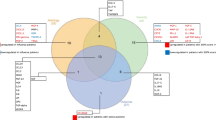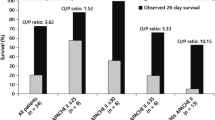Abstract
Blood purification therapy using hemofilters with high adsorbing capabilities has been reported to remove excessive humoral mediators from the blood of patients with sepsis. However, there are insufficient studies of the adsorbates bound to hemofilter membranes. We hypothesized that these adsorbates in acute kidney injury (AKI) patients with sepsis were different from those in patients without sepsis and that proteome analysis of the adsorbates would identify novel substances of sepsis. This study included 20 patients who had AKI upon admission to intensive care units (ICUs) and who received continuous renal replacement therapy using polymethyl methacrylate hemofilters. We isolated adsorbates from the hemofilters after use and performed comprehensive proteome analysis. A total of 429 proteins were identified in these adsorbates. Adsorbates from the hemofilters of patients with sepsis had significantly increased frequency of proteins associated with “immune system process” and “biological adhesion” functions compared to those of non-sepsis patients (P < 0.05). Of 429 proteins, 197 were identified only in sepsis adsorbates. Of these, 3 proteins including carbonic anhydrase 1 (CA1) and leucine-rich alpha-2-glycoprotein (LRG1) were identified in all samples from sepsis patients and have not been previously reported in sepsis patients. Validation analysis of patient serum revealed that patients with sepsis had increased serum levels of CA1 and LRG1 compared to patients without sepsis (P < 0.05). To conclude, there were significant differences in the characteristics of the adsorbates from sepsis and non-sepsis patients. CA1 and LRG1 appear to be novel substances associated with sepsis.

Similar content being viewed by others
References
Singer M, Deutschman CS, Seymour CW, Shankar-Hari M, Annane D, Bauer M, et al. The third international consensus definitions for sepsis and septic shock (Sepsis-3). JAMA. 2016;315:801–10.
Williams SC. After Xigris, researchers look to new targets to combat sepsis. Nat Med. 2012;18:1001.
Vincent JL, Opal SM, Marshall JC, Tracey KJ. Sepsis definitions: time for change. Lancet. 2013;381:774–5.
Matsuda K, Hirasawa H, Oda S, Shiga H, Nakanishi K. Current topics on cytokine removal technologies. Ther Apher. 2001;5:306–14.
Nakada TA, Hirasawa H, Oda S, Shiga H, Matsuda K. Blood purification for hypercytokinemia. Transfus Apher Sci. 2006;35:253–64.
Hirayama Y, Oda S, Wakabayashi K, Sadahiro T, Nakamura M, Watanabe E, et al. Comparison of interleukin-6 removal properties among hemofilters consisting of varying membrane materials and surface areas: an in vitro study. Blood Purif. 2011;31:18–25.
Hirasawa H, Oda S, Nakamura M, Watanabe E, Shiga H, Matsuda K. Continuous hemodiafiltration with a cytokine-adsorbing hemofilter for sepsis. Blood Purif. 2012;34:164–70.
Legrand M, Darmon M, Joannidis M, Payen D. Management of renal replacement therapy in ICU patients: an international survey. Intensive Care Med. 2013;39:101–8.
Cao Z, Robinson RA. The role of proteomics in understanding biological mechanisms of sepsis. Proteom Clin Appl. 2014;8:35–52.
Hattori N, Oda S, Sadahiro T, Nakamura M, Abe R, Shinozaki K, et al. YKL-40 identified by proteomic analysis as a biomarker of sepsis. Shock. 2009;32:393–400.
Bone RC, Balk RA, Cerra FB, Dellinger RP, Fein AM, Knaus WA, et al. Definitions for sepsis and organ failure and guidelines for the use of innovative therapies in sepsis. The ACCP/SCCM Consensus Conference Committee. American College of Chest Physicians/Society of Critical Care Medicine. Chest. 1992;101:1644–55.
Satoh M, Haruta-Satoh E, Omori A, Oh-Ishi M, Kodera Y, Furudate S, et al. Effect of thyroxine on abnormal pancreatic proteomes of the hypothyroid rdw rat. Proteomics. 2005;5:1113–24.
Rappsilber J, Mann M, Ishihama Y. Protocol for micro-purification, enrichment, pre-fractionation and storage of peptides for proteomics using StageTips. Nat Protoc. 2007;2:1896–906.
Okajima K, Harada N. Regulation of inflammatory responses by sensory neurons: molecular mechanism(s) and possible therapeutic applications. Curr Med Chem. 2006;13:2241–51.
Cummings CJ, Sessler CN, Beall LD, Fisher BJ, Best AM, Fowler AA 3rd. Soluble E-selectin levels in sepsis and critical illness. Correlation with infection and hemodynamic dysfunction. Am J Respir Crit Care Med. 1997;156:431–7.
Tolwani A. Continuous renal-replacement therapy for acute kidney injury. N Engl J Med. 2012;367:2505–14.
Uchino S, Kellum JA, Bellomo R, Doig GS, Morimatsu H, Morgera S, et al. Acute renal failure in critically ill patients: a multinational, multicenter study. JAMA. 2005;294:813–8.
Schrier RW, Wang W. Acute renal failure and sepsis. N Engl J Med. 2004;351:159–69.
Kalenka A, Feldmann RE Jr, Otero K, Maurer MH, Waschke KF, Fiedler F. Changes in the serum proteome of patients with sepsis and septic shock. Anesth Analg. 2006;103:1522–6.
Ando T, Iizuka N, Sato T, Chikada M, Kurokawa MS, Arito M, et al. Autoantigenicity of carbonic anhydrase 1 in patients with abdominal aortic aneurysm, revealed by proteomic surveillance. Hum Immunol. 2013;74:852–7.
Yagi S, Abe M, Yamashita M, Mori K, Yamanishi H, Arimitsu E, et al. Carbonic anhydrate I epitope peptide improves inflammation in a murine model of inflammatory bowel disease. Inflamm Bowel Dis. 2016;22:1835–46.
O’Donnell LC, Druhan LJ, Avalos BR. Molecular characterization and expression analysis of leucine-rich alpha2-glycoprotein, a novel marker of granulocytic differentiation. J Leukoc Biol. 2002;72:478–85.
Serada S, Fujimoto M, Ogata A, Terabe F, Hirano T, Iijima H, et al. iTRAQ-based proteomic identification of leucine-rich alpha-2 glycoprotein as a novel inflammatory biomarker in autoimmune diseases. Ann Rheum Dis. 2010;69:770–4.
Wang X, Abraham S, McKenzie JA, Jeffs N, Swire M, Tripathi VB, et al. LRG1 promotes angiogenesis by modulating endothelial TGF-beta signalling. Nature. 2013;499:306–11.
Moore E, Bellomo R, Nichol A. Biomarkers of acute kidney injury in anesthesia, intensive care and major surgery: from the bench to clinical research to clinical practice. Minerva Anestesiol. 2010;76:425–40.
Sprong T, Roos D, Weemaes C, Neeleman C, Geesing CL, Mollnes TE, et al. Deficient alternative complement pathway activation due to factor D deficiency by 2 novel mutations in the complement factor D gene in a family with meningococcal infections. Blood. 2006;107:4865–70.
Fernandez-Celemin L, Thissen JP. Interleukin-6 stimulates hepatic insulin-like growth factor binding protein-4 messenger ribonucleic acid and protein. Endocrinology. 2001;142:241–8.
Jennewein C, Tran N, Paulus P, Ellinghaus P, Eble JA, Zacharowski K. Novel aspects of fibrin(ogen) fragments during inflammation. Mol Med. 2011;17:568–73.
Chen Y, Han H, Yan X, Ding F, Su X, Wang H, et al. Tetranectin as a potential biomarker for stable coronary artery disease. Sci Rep. 2015;5:17632.
Nelson A, Berkestedt I, Bodelsson M. Circulating glycosaminoglycan species in septic shock. Acta Anaesthesiol Scand. 2014;58:36–43.
Vantaku VR, Gupta G, Rapalli KC, Karnati R. Lacritin Salvages human corneal epithelial cells from lipopolysaccharide induced cell death. Sci Rep. 2015;5:18362.
Acknowledgements
This work was supported by Yoshimi Memorial T.M.P. Grant. We thank Fumie Iida for her technical expertise. Dr. Nakada and Hashida are inventors in a patent application filed and maintained by Chiba University related to this work.
Author information
Authors and Affiliations
Corresponding author
Ethics declarations
Conflict of interest
The authors declare that they have no conflict of interest.
Rights and permissions
About this article
Cite this article
Hashida, T., Nakada, Ta., Satoh, M. et al. Proteome analysis of hemofilter adsorbates to identify novel substances of sepsis: a pilot study. J Artif Organs 20, 132–137 (2017). https://doi.org/10.1007/s10047-016-0936-3
Received:
Accepted:
Published:
Issue Date:
DOI: https://doi.org/10.1007/s10047-016-0936-3




